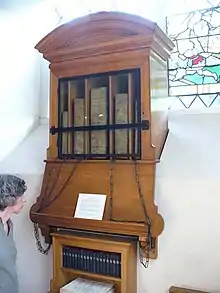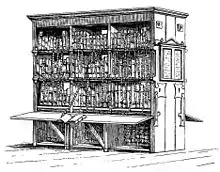Chained library
A chained library is a library where the books are attached to their bookcase by a chain, which is sufficiently long to allow the books to be taken from their shelves and read, but not removed from the library itself. This would prevent theft of the library's materials.[1] However, it also led to crowding and awkwardness when readers had to stand side by side, each holding a book or clumping so they could share one.[2] The practice was usual for reference libraries (that is, the vast majority of libraries) from the Middle Ages to approximately the 18th century. However, since the chaining process was also expensive, it was not used on all books.[3] Only the more valuable books in a collection were chained.[3] This included reference books and large books.[3]

It is standard for chained libraries to have the chain fitted to the corner or cover of a book. This is because if the chain were to be placed on the spine the book would suffer greater wear from the stress of moving it on and off the shelf. Because of the location of the chain attached to the book (via a ringlet) the books are housed with their spine facing away from the reader with only the pages' fore-edges visible (that is, the 'wrong' way round to people accustomed to contemporary libraries). This is so that each book can be removed and opened without needing to be turned around, hence avoiding tangling its chain. To remove the book from the chain, the librarian would use a key.[4]

The earliest example in England of a library to be endowed for use outside an institution such as a school or college was the Francis Trigge Chained Library in Grantham, Lincolnshire, established in 1598. The library still exists and can justifiably claim to be the forerunner of later public library systems. Marsh's Library in Dublin, built 1701, is another non-institutional library which is still housed in its original building. Here it was not the books that were chained, but rather the readers were locked into cages to prevent rare volumes from 'wandering'. There is also an example of a chained library in the Royal Grammar School, Guildford, as well as at Bolton School. Hereford Cathedral has the largest surviving chained library. While chaining books was a popular practice throughout Europe, it was not used in all libraries. The practice of chaining library books became less popular as printing increased and books became less expensive.[4] Wimborne Minster in Dorset, England is yet another example of a Chained Library. It is one of the first in England and the second (recently demoted to 3rd as Wells Cathedral chained library recently re-chained a number of their books) largest.[5]
The Hereford Cathedral, located in Hereford, England is one of two chained libraries that still have chained books on its shelves.[6] The book pages were said to be made of cowhide, wood, leaves, clay, cloth, bark, metal, and unbleached animal skin, and was written in the language of the people. Under-privileged scholars settled for columns of text bounded between boards and papyrus. Papyrus was cheaper but could easily be destroyed and written over. [7]
In the Middle Ages, books were expensive and for the privileged, but they were highly valued. Books were left neglected and had fallen in disrepair. Books were the prime target for thieves and impoverished students to steal and resale. As a result, books were chained to shelves to preserve information.[7]
Recent interest in saving and preserving chained libraries
Recently, there has been increased interest in reconstructing chained libraries. Worldwide, only five chained libraries have survived with their original furniture, chains, and books.[1] This includes the library built in the Church of Saint Walpurga, located in the small town of Zutphen in the Netherlands.[1] This library was built in 1564.[1] The library is now part of a museum that allows visitors to tour and view the library's original books, furniture, and chains.[1] Another chained library is the Malatestiana Library in Cesena near Bologna in Italy, dating back to the Italian Renaissance. A lot of work has gone into rebuilding and preserving these great libraries.[4]
For example, many workers, over a decade, and massive monetary donations were spent to restore the Mappa Mundi and Chained Library museum located in Hereford, England.[4] Built over 900 years ago, the library fell into disrepair and faced destruction.[4] The oldest chained book found in the library is the Hereford Gospels.[8] Written in the eighth century, it is one of 229 chained books located in this great library.[8] The Hereford library is the largest surviving chained library with its chains and books intact.[8] The library is now open to the public as a tourist attraction and museum.[4]
The chained library in Wimborne Minster is the second-largest chained library in the UK. The first donation came from Revd William Stone. These were theological books, used mainly by the clergy and therefore were not chained. When another local donor, Roger Gillingham, gave another 90 books in 1695, he insisted that the books be chained up, but also that the Library should be opened, free, for the people of the town, providing they were 'shopkeepers or the better class of person'.[9]
Surviving examples of chained libraries

- Bolton School, Bolton, Lancashire, England[10]
- Chelsea Old Church, London, England
- Chetham's Library, Manchester, England houses the chained parish library of Gorton[11]
- Church of All Saints, Wrington, Somerset, England[12]
- Church of St John the Baptist, Glastonbury, England[13]
- Francis Trigge Chained Library, Grantham, England
- Hereford Cathedral Library, Hereford, England
- Malatestiana Library, Cesena, Italy
- Royal Grammar School, Guildford, England
- St Peter's Church, Wootton Wawen, Warwickshire, England
- St Walburga's Church, Zutphen, The Netherlands
- Trinity Hall, Cambridge, England
- Wimborne Minster, England
- Wells Cathedral, Somerset, England
Chained libraries in popular culture
- In Terry Pratchett's Discworld series of comic fantasy novels, the library of the magical Unseen University also has a number of chained books—however, in this case, the purpose of the chains is to prevent the more vicious magical books from escaping or attacking passers-by.
- David Williams has written a mystery, Murder in Advent, that features a chained library.[14]
- In the film Harry Potter and the Philosopher's Stone, the Restricted section of the library features chained books.
- In the season six finale of Game of Thrones, Samwell Tarly is granted access to the Citadel Library where many of the books are chained.
- In the film Doctor Strange, the library of Kamar-Taj is home to countless ancient books, but some books are forbidden and on chains and watched over by the librarian, Wong.
See also
References
- Weston, J. (10 May 2013). "The Last of the Great Chained Libraries".
- Murray, S. (2009). The library : an illustrated history. New York, NY : Skyhorse Pub. ; Chicago : ALA Editions, 2009. p. 65
- Byrne, D. "Chained libraries". History Today, May 1987, 37, pp. 5–6.
- Lopez, B. "New Chained Library of Hereford Cathedral Takes Royal Prize". American Libraries, 1997, p. 22.
- Ltd, Triple W Software. "Chained Library – Wimborne Minster". www.wimborneminster.org.uk. Retrieved 26 September 2015.
- Allison. "Reading in Restraint: The Last Chained Libraries". Atlas Obscura. 9.
- Lyons, Martyn (2011). A Living History. Los Angeles. pp. 35–46.
- Hereford Cathedral. "The Chained Library". 2009. Received from "The chained library". herefordcathedral.org. Archived from the original on 14 February 2013. Retrieved 1 April 2013.
- Wimborne Minster. "Chained library". 2014.
- School, Bolton. "Local, Special and School Archival Collections". Bolton School. Retrieved 30 September 2019.
- "Chetham's Library | Library of the Parish Church of Gorton". Chetham's Library. Retrieved 30 September 2019.
- "chainbooks". www.wringtonsomerset.org.uk. Retrieved 30 September 2019.
- "Chained books". stjohns-glastonbury.org. Archived from the original on 15 August 2017. Retrieved 29 September 2019.
- Heald, Tim (6 October 2013). "David Williams obituary". The Independent. Archived from the original on 21 October 2010. Retrieved 10 November 2010.
Bibliography
- William Blades, Books in chains : and other bibliographical papers. London: Elliot Stock, 1892.
- John Charles Cox & Alfred Harvey, English church furniture. Chapter XI: 'Church libraries and chained books.' Second edition. London: Methuen, 1908.
- B.H. Streeter, The Chained Library: a survey of four centuries in the evolution of the English library. London: Macmillan, 1931.
- Philippe Cordez: Le lieu du texte. Les livres enchaînés au Moyen Âge. In: Revue Mabillon 78, 2006, ISSN 0035-3620, p. 75–103.
External links
- The Mappa Mundi and Chained Library at Hereford Cathedral – accessed 26 June 2011
(Wayback Machine copy)
(Wayback Machine copy)
- Wimborne Minster Chained Library
- Oriel College Library
- A chained library surviving at a school (The Royal Grammar School, Guildford) – accessed 6 January 2007
(Wayback Machine copy)
- Bolton School Boys Division: The Chained Library
- Chain Reaction: The Practice of Chaining Books in European Libraries – An overview of the practice of chaining libraries – accessed 6 January 2007
- Marsh's Library